Future of SEO: 13 Biggest SEO Trends of 2025 and Beyond with AI

These 13 SEO trends will shape the future of SEO. Learn how search is evolving with AI and how to adapt.
The SEO industry is a fast-moving train.
In the past 24 months, Google rolled out a total of 16 algorithm updates.
9 in 2023 and 7 in 2024.

Core updates, spam updates, helpful content updates…name it.
These updates are so much that keeping up with them is like hitting a moving target.
In a HubSpot survey of 400 websites, 50% of marketers cited staying up to date with algorithm changes as their biggest SEO challenge.
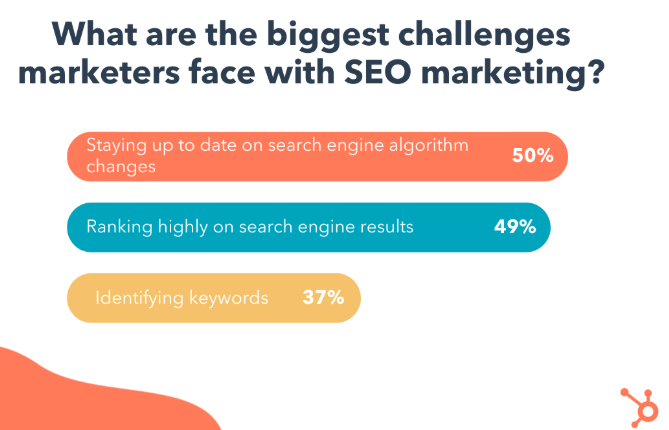
With the pervasive adoption of AI, the emergence of LLM search engines, and Google’s intensifying emphasis on E-E-A-T, you can expect even more algorithm changes in 2025.
But besides these incessant algorithm acrobatics, a lot is on in this $200+ billion market.
After a highly eventful 2024, I’m here to give you a lowdown on the SEO trends that will define the search market in 2025 and possibly beyond.
Of course, creating high-quality helpful content, optimizing for relevant keywords, and building backlinks are still the foundation of an effective SEO strategy.
However, as it stands, businesses (especially new or small ones) have to do more to earn Google and searcher’s trust in 2025.
Here are the top 13 SEO trends already defining search in 2025.
1. AI Overviews Have Changed SERP Forever
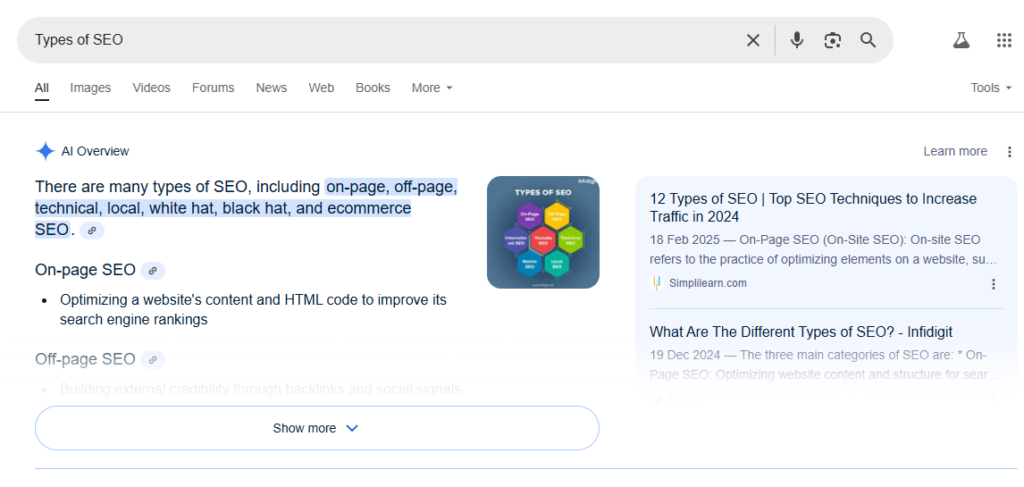
Formerly Search Generative Experience (SGE), the introduction of AI Overview is one of the SEO events that has had the most significant impact on searches in the history of the internet.
After a year of testing, Google finally rolled out this feature throughout the United States in May 2024 with AI overview appearing in 84% of searches.
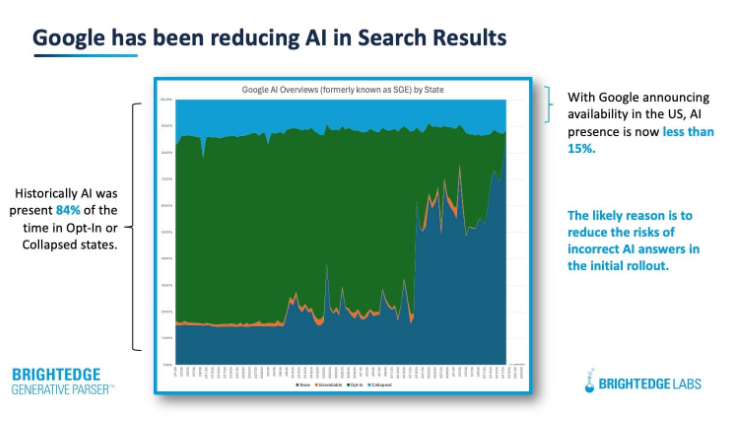
Later in 2024, Google cut the appearance of generative AI in searches to about 14% due to quality issues.
Some marketers cite wrong and dangerous AI answers as the major reason behind this rollback.
It wasn’t surprising as most generative AIs are error-prone. ChatGPT boldly displays this on its website.
“ChatGPT can make mistakes. Check Important Info”.
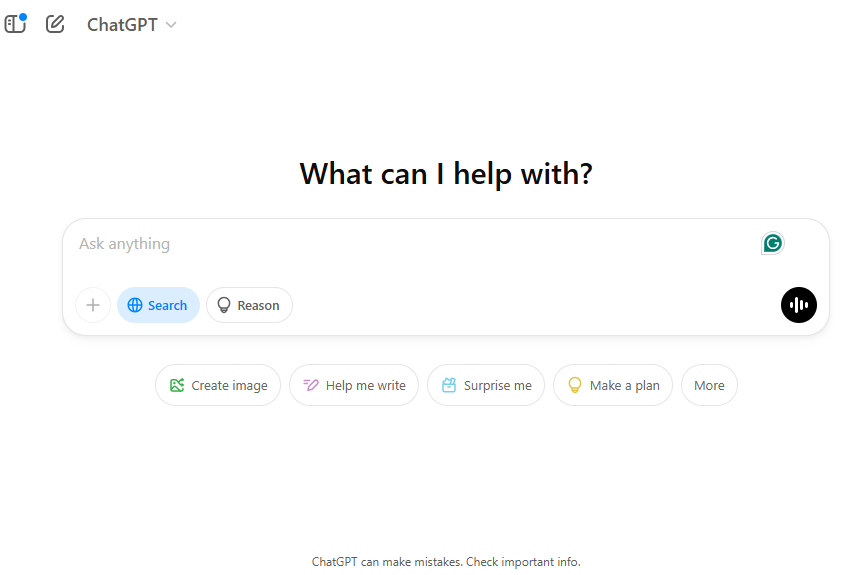
Google doesn’t shy away from the same fact. But unlike ChatGPT, the search giant uses a more subtle approach.
“Generative AI is experimental”
Users only see this disclaimer after clicking the “Show More” button at the bottom of AI overviews.
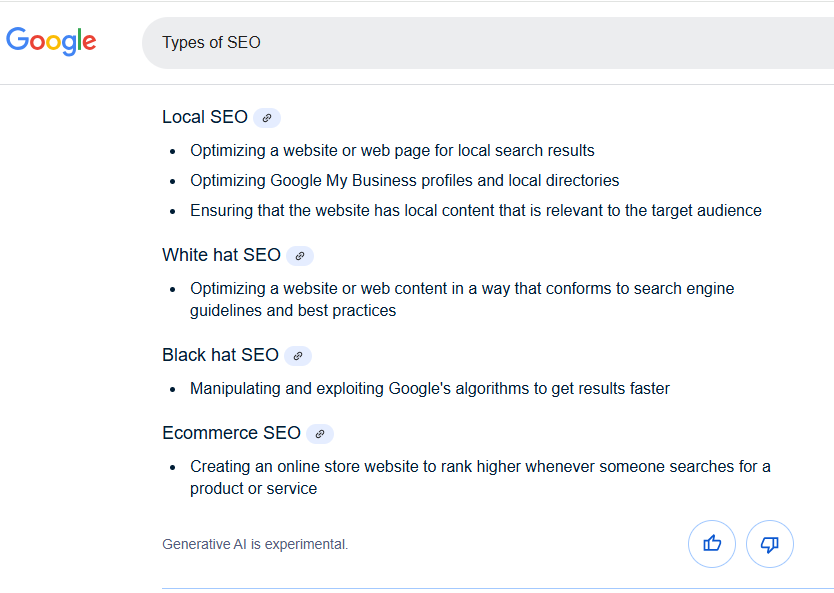
Search Is Getting More Conversational
In 2025, we’ve seen AI Overview gradually returning to SERPs.
About 25% of searches now feature one.
While still under experimentation, Google seems to have fixed some of the failures of AI Overviews.
Experts predict the appearance of AIOs in more complex searches because of this improvement.
For instance, in 2024, more than 90% of all AI overviews appear for broad informational keywords.
Today, we see more AI Overviews for commercial and transactional long-tail keywords.
In a recent study, Moz analyzed 46,000 keywords.
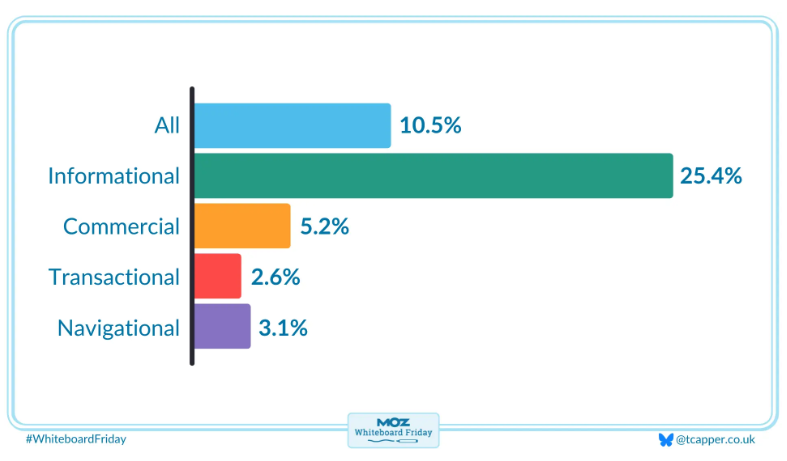
The study found that AI overview appears in 5.2% and 2.6% of commercial and transactional intent searches respectively.
As Google stated, searchers can now ask even the “most complex local searches question” and get accurate AI-generated results, which means searches are now more conversational.
To test this claim, I tried a series of long, conversational local queries, and here’s the result.
I started by searching “Who’s the best dermatologist for acne in Los Angeles?”

Then, “Give me a list of best litigation attorneys in Washington DC”
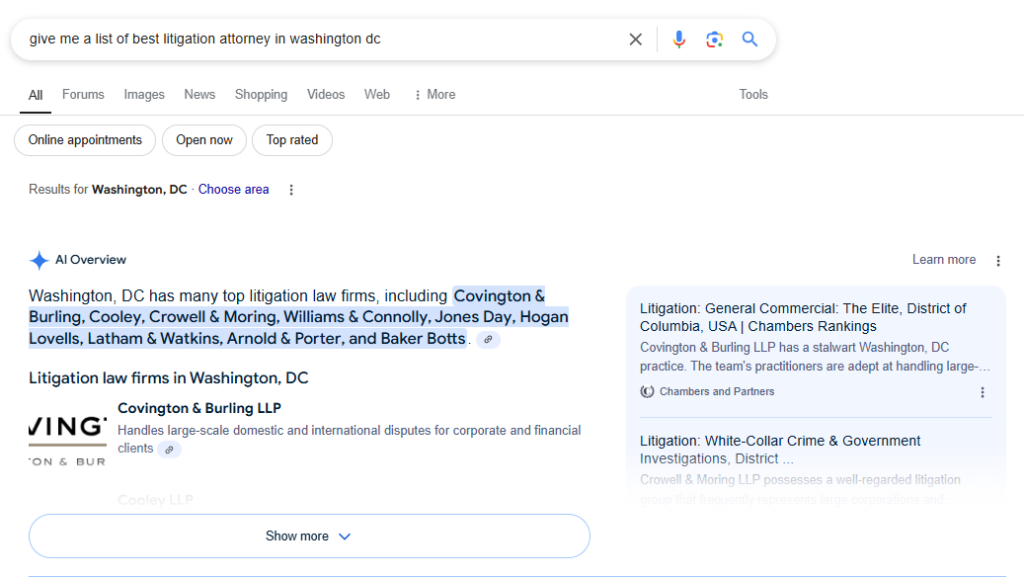
Even for queries I didn’t specify any location, “Who are the top realtors for luxury homes”
The AI overview answers were relevant to my location
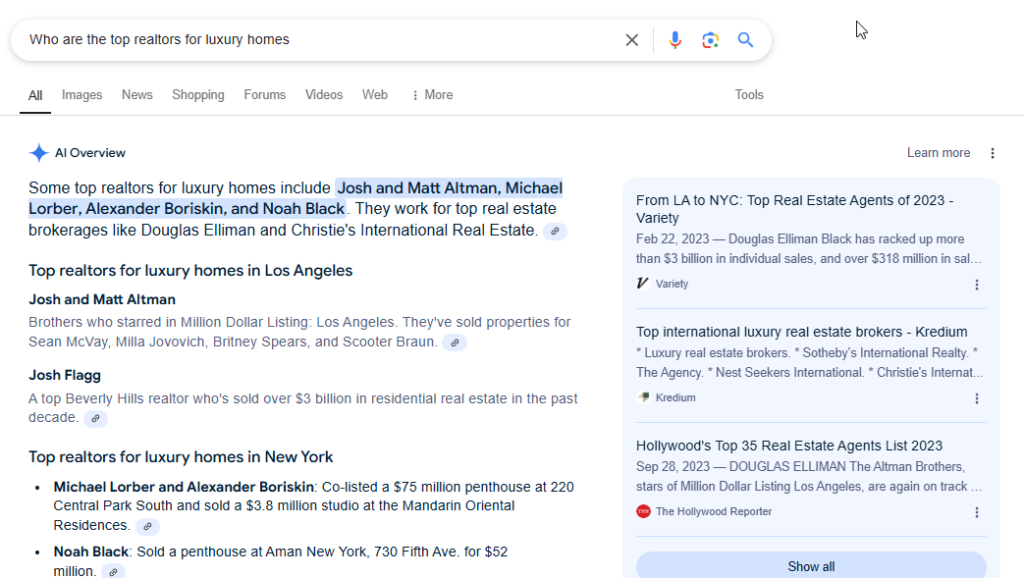
I tried even longer queries;
“If I need a top-rated criminal defense attorney in Atlanta who’s great at defending high-profile cases, who should I reach out to?”
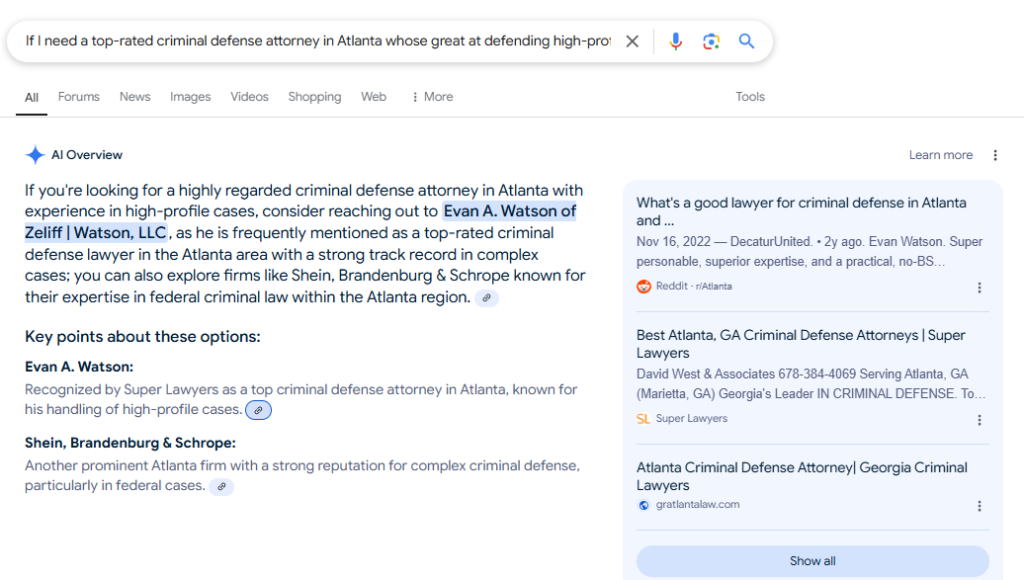
Impressive! Right?
But what does all this mean for your organic search visibility?
No doubt, generative AI in searches enhances user experience by delivering quick answers as demonstrated above.
However, its impact on website visibility and traffic is not very friendly, at least for the moment.
That brings us to the second SEO trend of 2025.
2. Organic Click-Through Rates (CTR) Continue to Decline
For years, ranking in the top 3 of SERPs has been the holy grail of SEO.
Websites in these positions receive more than two-thirds, 68.7% of all clicks on the result page.
AI overview is changing this dynamic, and fast.
Unlike traditional search results, which list websites, AI Overview synthesizes information from multiple sources to provide direct answers.
Google’s AI Overview uses a combination of natural language processing (NLP) and machine learning to understand user intent.
It scans top-ranking pages, extracts relevant information, and presents it to users in a concise, easy-to-read format.
Here’s an example:
If a user searches “best time to post on social media,” the AI will pull data from blogs, studies, and forums to create a summary.
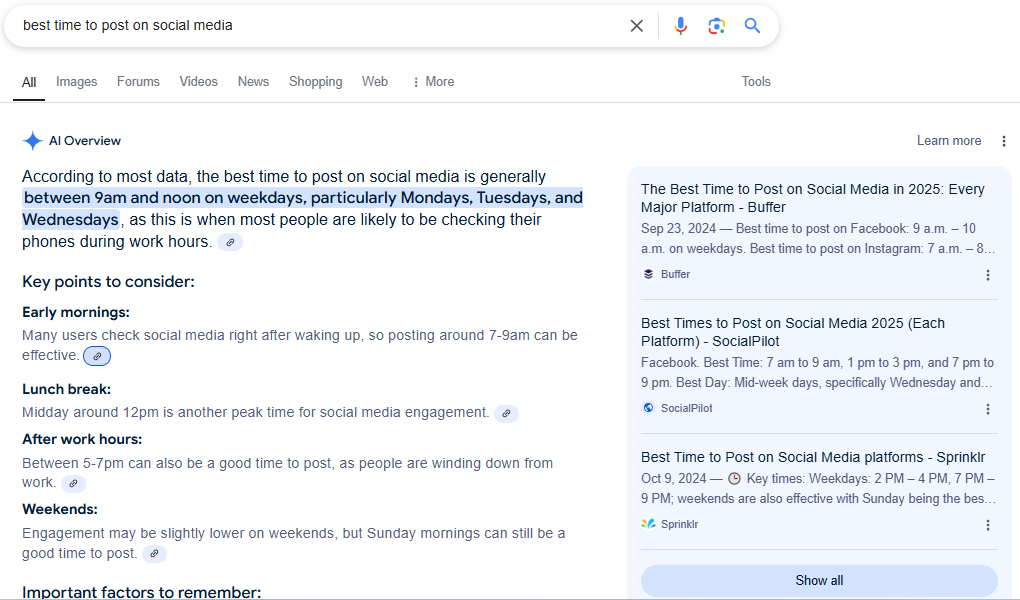
So, instead of wading through several websites to find answers, it helps them find quick answers.
Thus, users may no longer visit websites to satisfy their search intent.
The effect? Already far-reaching…
Since Google added AI Overviews to search, organic traffic has nosedived generally.
A 2024 study by Gilad David Maayan, CEO and founder of Agile SEO found that organic traffic has dropped by 18-64% (depending on industry) since Google launched AI Overviews.
This trend is further supported by a recent case study by digital marketing agency, Seer Interactive which analyzed 10,000 informational keywords.
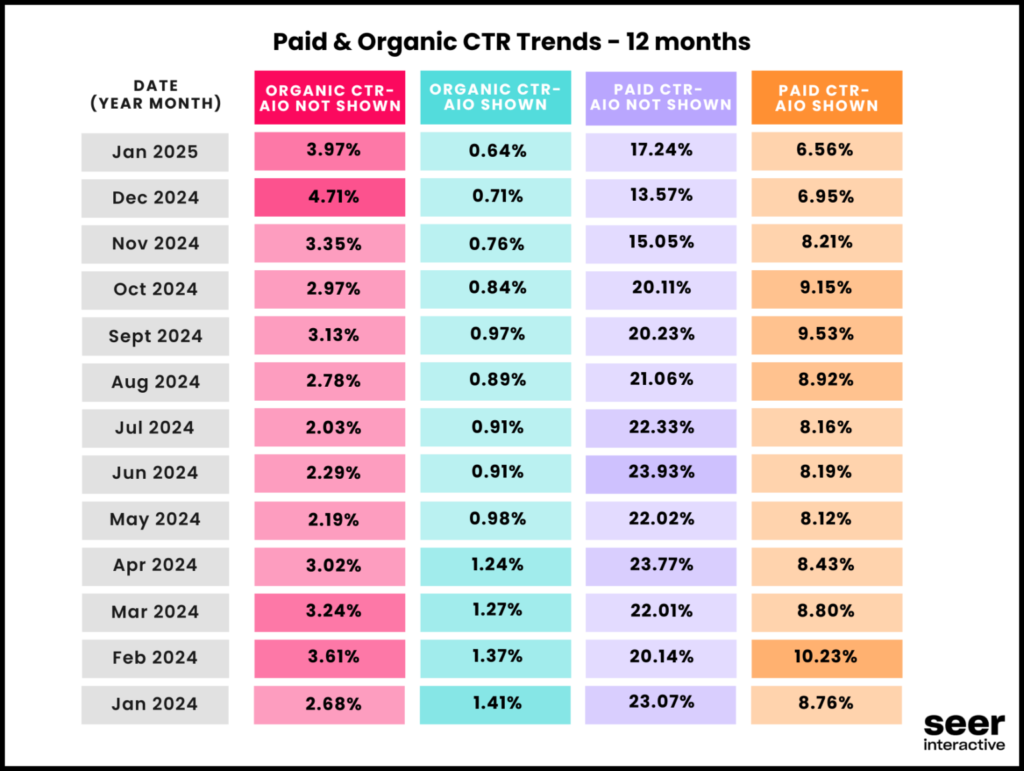
The study revealed that organic CTRs for queries featuring AI Overviews dropped sharply from 1.41% to 0.64%, year over year.
Organic CTR declined by approximately 70% when an AIO was present on the SERPs.
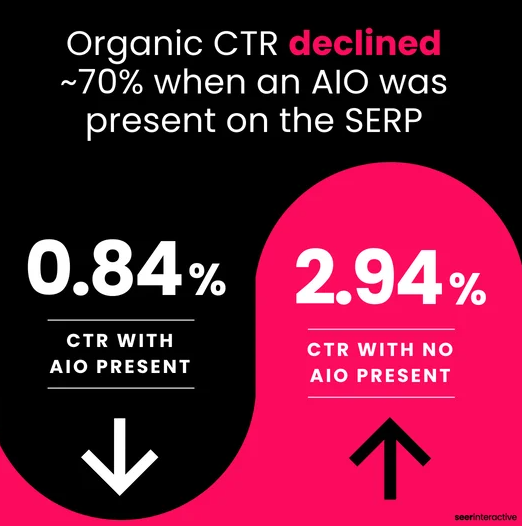
Since AI Overviews aggregate information from various web sources, it uses your website’s content to generate summaries without directing users to your site.
This practice has raised concerns, as filed in a recent Chegg lawsuit against Google.
The suit alleges that AI Overviews diminish demand for original content and harm publishers’ competitiveness.
3. Ranking High in SERP Still Matters for AI Overview Ranking
On average, AI overview cites 4-6 webpages in the link cards section.
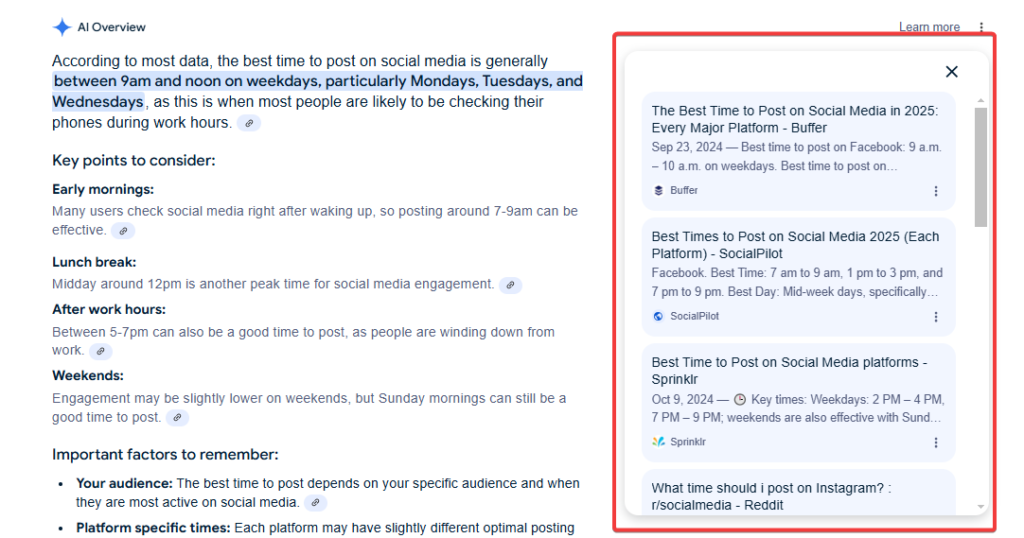
More often than not, these web pages are from websites ranking high on the SERP.
That means quality content can still get you ranked in AIO link cards.
The science behind that is simple.
If Google sees your content as authoritative and ranks it high on SERPs, AI overviews will likely do the same.
So, ranking high in SERP gives you a better chance of being featured in AI Overviews.
Several studies have validated this theory.
According to this Botify AI Overview study, 75% of Google AI Overview links come from the top 12 organic rankings.
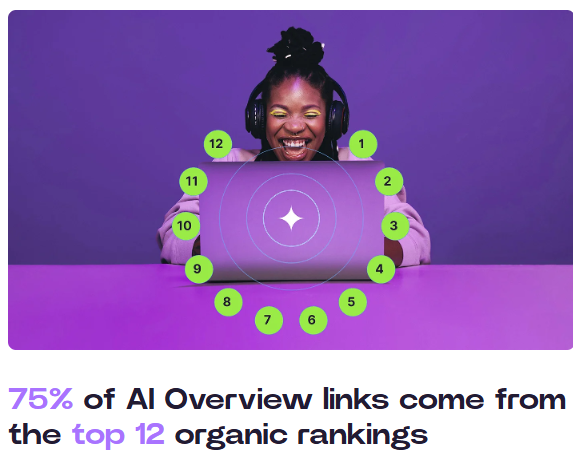
Similarly, A recent analysis of 11,203 keywords by Authoritas, an e-commerce SEO platform, found that 60% of the time, pages ranking in the top 10 organic search results appear in AI overview.
In the video below, Matt Lenhard, Co-founder, and CTO of Positional speaks on the mechanics of AI Overviews.
He revealed that according to their numerous case studies, the #1 ranked organic search result has a 55% greater chance to appear in AI overviews than the #2 results. A similar scenario plays out going down the page.
All of these findings align with Laurence O’Toole’s 2024 study:
“If a page ranks in one of the top 3 places in the organic results, there is a 55.2% chance that it will rank in some position in the AIO results.”
“if a page ranks in any position in the top 10 places in the organic results, there is a 44.4% chance that it will rank in some position in the AIO results.”
4. Small Websites Now Rank in AI Overviews Link Card
Understandably, AI Overview gives a larger chunk of its citation links to big brands.
However, there seems to be an opportunity for small businesses and niche sites with quality content.
I’ve experienced this firsthand. The website you are currently on is fairly new. I started publishing SEO and marketing guides 2 months ago.
And I’ve seen my content ranked in AI Overview link cards. Not once.
For better context, my website DA is 8 (as measured by Semrush).
Sometimes, Google skips all the top 3 results to show websites in position 7-9 in AI overviews.
The Authoritas report above also showed that, 40% of the time, AI Overviews list web pages that aren’t in the SERP top 10 in link cards.
I’ve also seen AI Overview links to web pages that aren’t in the top 10.
That means that Google is ready to go as far as to provide the most accurate results to users.
So the old narrative of big brands always outranking small websites (with better content) is about to change.
I.M.O
5. AI Overviews Are Driving More Traffic than Featured Snippet
Despite all the initial fear about AI Overviews killing organic SEO, there are still some net positives in its birth.
AI Overviews have been proven to drive higher click-through rates (CTR) than traditional featured snippets.
When Sistrix analyzed 18 million websites, it found that Google’s AI Overviews in the top position drive more traffic to websites than featured snippets in the same position.
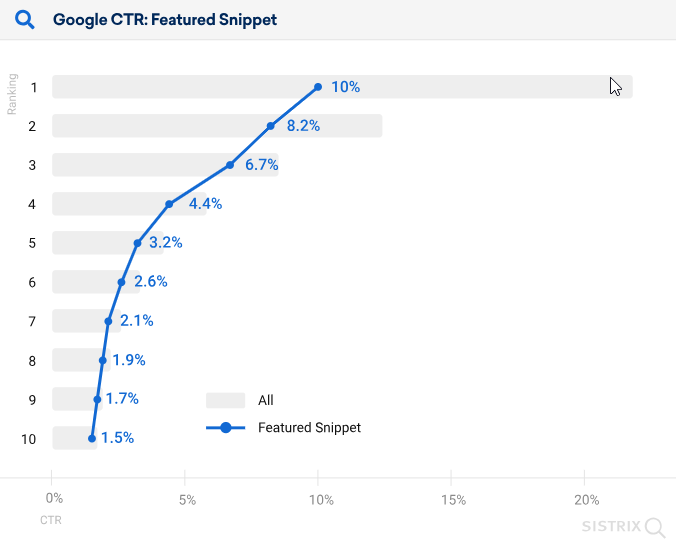
AI overview links in position #1 have 12.5% CTR compared to 10% of featured snippets.
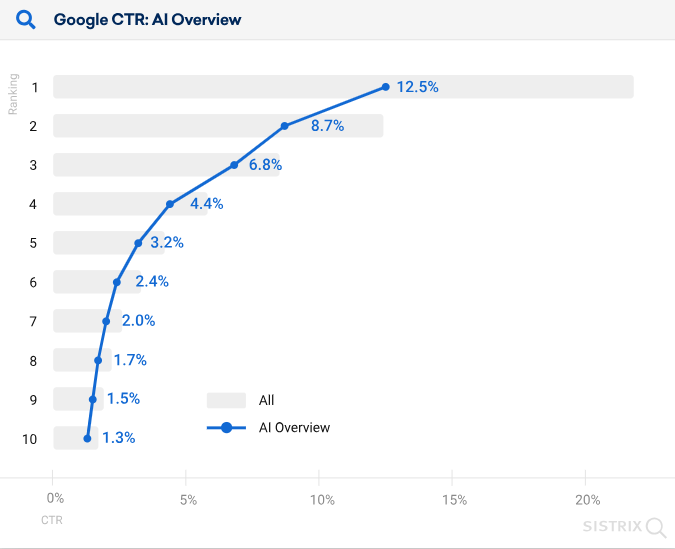
At the moment, the reasons behind this are, at best, speculative.
This may be due to the multiple sources provided by AI overview, which encourages users to explore various websites.
Some experts argue that this stems from users’ distrust of AI-generated answers, prompting them to verify from multiple sources.
Regardless of the motivation, this search behavior suggests a more optimistic outlook.
6. AI Overviews Drive More Qualified Traffic
From my evaluation, AI Overviews drive more qualified traffic than traditional organic results.
Liz Reid, VP, Head of Google Search wrote;
“User feedback shows that with AI Overviews, people have higher satisfaction with their search results, and they’re asking longer, more complex questions that they know Google can now help with.”
This means that clicks generated through AI Overviews are more intentional and targeted.
For reasons:
- AI Overviews are intent-based: AI Overviews curate and summarize information from multiple sources. Instead of users clicking multiple links and skimming articles, AI delivers concise, targeted answers. The traffic that does click through is more likely to be engaged and interested in deeper insights.
- Users Are Pre-Qualified Before Clicking: Users who click through from an AI overview typically have a stronger intent to find specific information related to their search query, as the AI has already provided a basic understanding.
- Less Bounce Rate: Since the AI overview pre-screens the information, users are more likely to find what they need on the webpage they land on, leading to lower bounce rates.
- AI Highlights Expertise & Authority: AI-generated responses often prioritize authoritative sources and trusted brands, meaning the traffic from these overviews is more likely to convert because users trust the recommendation.
Senior Data Scientist at Terakeet Engineering Adi Srikanth studied the impact of AIOs on web traffic for transactional queries.
He found that web pages included in AI Overviews get more traffic.
These pages receive 3.2x as many clicks as pages not featured, regardless of position on page 1 of Google.
7. LLMs Are Stealing Searchers from Google
The rise of Large Language Models (LLMs) like ChatGPT, Claude, and Perplexity AI is ushering in a new era of search.
Before them, you and I search Google for almost everything; software for our business, luxury holiday destinations, best gaming laptops, etc.
LLMs offer a faster and even sometimes better way to get answers to our questions.
The adoption of these tools has been exploding in recent months and this uptick is likely to continue for a long time.
ChatGPT now has 400 million weekly users, up 30% in the last 3-4 months.
As of January 2025, Perplexity AI boasts 15 million monthly active users, up from just 2 million in 2023.
These are all Google users from a few years ago.
Of course, most searchers still use Google. However, the number of users who no longer see traditional search engines like Google and Bing as first options keeps growing.
According to Statista, approximately 13 million adults in the United States reported using generative AI as their main tool for online searches.
This figure is expected to surpass 90 million users by 2027.
Additionally, about 68% of U.S. adults said they use generative AI to find answers to their questions.
The reason isn’t far-fetched.
Search engines offer a one-way interaction. LLMs provide context-based conversation.
LLMs allow users to ask complex questions and their answers are direct and conversational.
Instead of sifting through 10 blue links to find the best CRM software, a user can ask ChatGPT:
“What’s the best CRM for a small business with a budget under $50/month?” and get a tailored response in seconds.
Ignite Visibility CEO, John Lincoln surveyed 170 LinkedIn users.
In the poll, 62% of the 170 respondents confirmed they use ChatGPT or Google Gemini for services and product research.
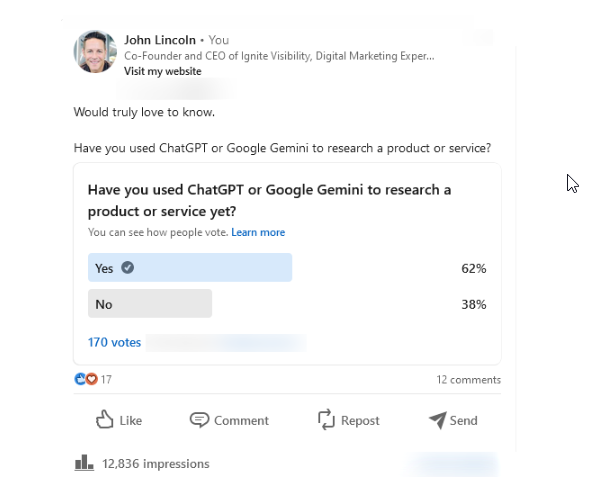
And it’s not just individuals.
Businesses now use LLMs for market research, content creation, and customer support.
In the most recent McKinsey Global Survey on AI, 65% of respondents said their organization now uses gen AI in at least one business function.
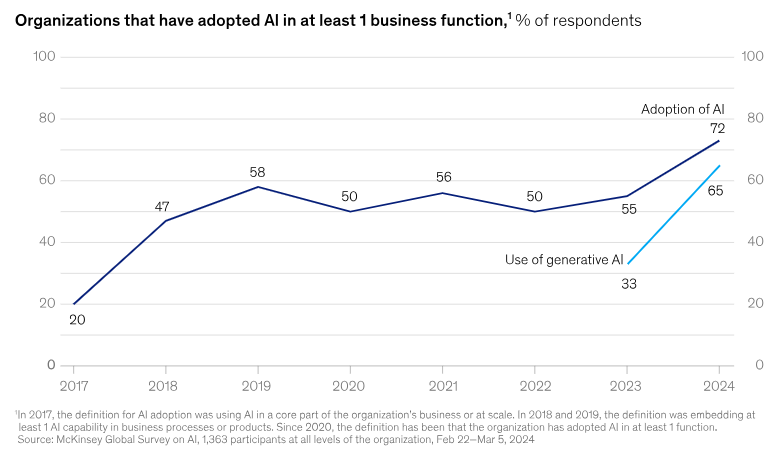
8. AI Search Engines Are Taking Searches Completely off Google
There have been 2 major arguments against LLMs finally replacing search engines:
- Knowledge Limitation: LLMs’ knowledge is limited to their training data. They don’t have access to the latest information on the web. So, their answers aren’t accurate and shouldn’t be relied on to make important decisions.
- Depth Limitation: LLMs can only offer quick answers to high-level informational questions. They do not provide sources from where they get their answers. They aren’t ideal for in-depth research on a topic. In short, they are purely generative, not explorative.
2025 LLM-powered search engines have surpassed these limitations.
ChatGPT, Perplexity AI, and even Google Gemini offer all the above.
Today, these tools are taking searches completely off Google.
Here, I’ll focus on the 2 biggest AI answer engines, ChatGPT Search and Perplexity AI.
ChatGPT Search
In July 2024, OPEN AI announced SearchGPT (only available to waitlist users), a prototype search engine that combines the features of traditional search engines with the generative power of LLMs.
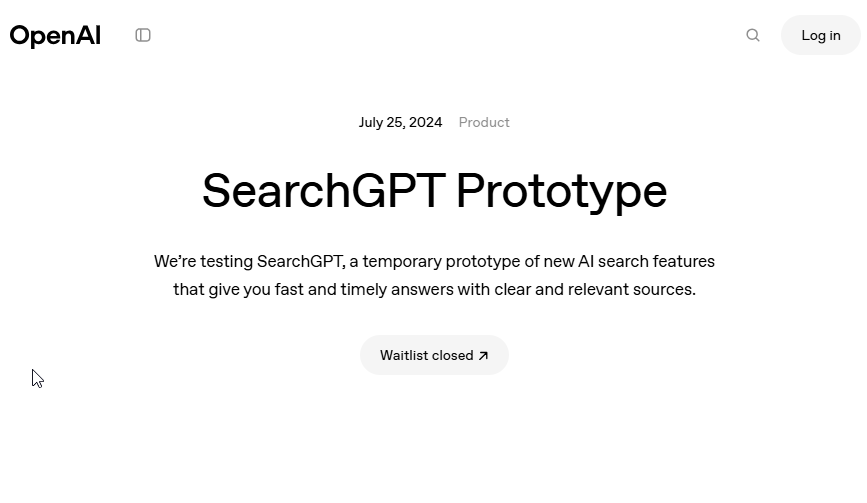
Fast forward to December 2024, the company integrated some features of SearchGPT into ChatGPT to give the world what’s now referred to as ChatGPT search.
ChatGPT search is available for free even for users without an account.
Users no longer need to leave the app or sift through countless links to find information on the web.
Simply tap the web search icon on the chat. Type in your query, and let ChatGPT pull results from the web.
I typed in the query “Types of SEO” into ChatGPT search and here’s the result:
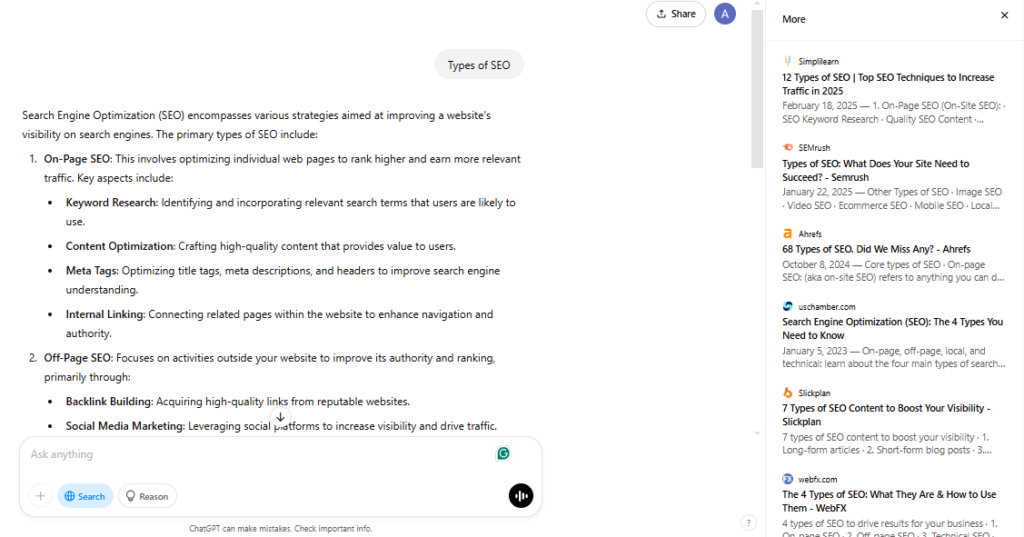
Like AI Overviews, ChatGPT gives a summary of different types of SEO and provides a list of the sources called citations.
Instinctively, I performed the same search on Google.
To my surprise, about 80% of the SERP top 10 are in ChatGPT search citations.
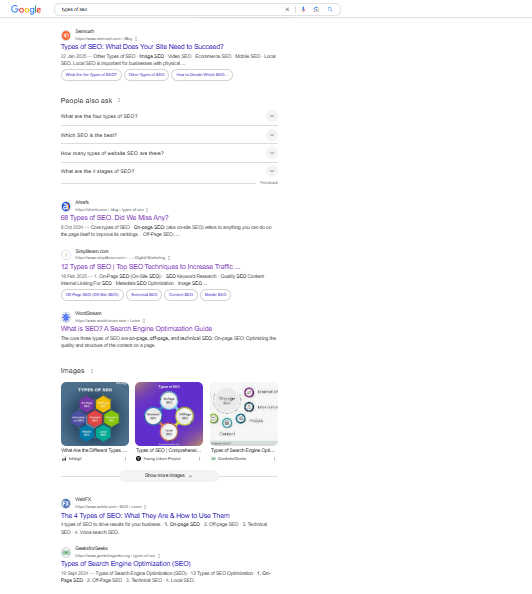
Is this another SEO trend? I’ve got some research to do. (We’ll discuss this in the next section)
For now, let’s get to the trend we are on.
Next, I perform a local search, “Who’s the best dermatologist for acne in Los Angeles?“.
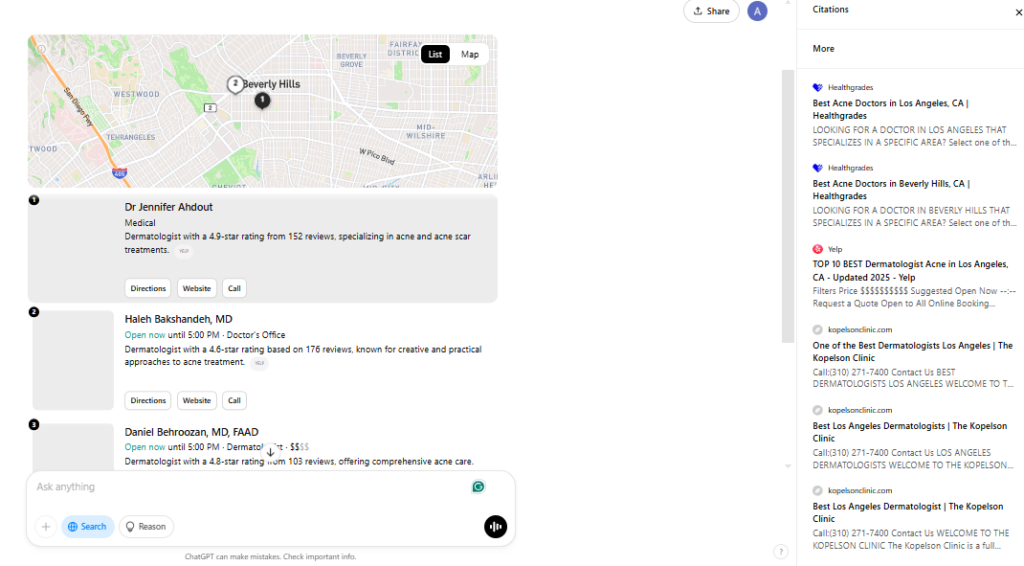
Again, just like Google would, ChatGPT search gave me a map with 3 highly-rated dermatologists in the Los Angeles area who specialize in acne treatment.
Each card has a Direction, Website and Call button. Only that, this time, the citation doesn’t match Google local SERPs.
One thing that sets ChatGPT search apart is that I can ask follow-up questions, clarify my intent, and refine queries based on the responses.
I can also build on past conversations as ChatGPT search can save and remember the context of your chat.
With Google, I’ll have to perform individual searches for those queries, no matter how closely related.
This level of detail and personalization is why 76% of users prefer AI-powered search engines for complex queries.
Perplexity AI
Perplexity AI is another answer engine stealing searchers from Google.
According to Denis Yarats, Co-Founder and CTO at Perplexity AI, the world needs a better gateway to the web.
He shares:
“Google’s search engine is the most sophisticated machine humanity has ever built, but I think there are certain things that can be done better. Specifically, you can save a lot of time when you don’t have to sift through 10 links and do a lot of the manual work yourself.”
Perplexity AI uses semantic search technology. It understands the meaning behind search queries to serve users contextually relevant results.
Let’s repeat the same query as above.
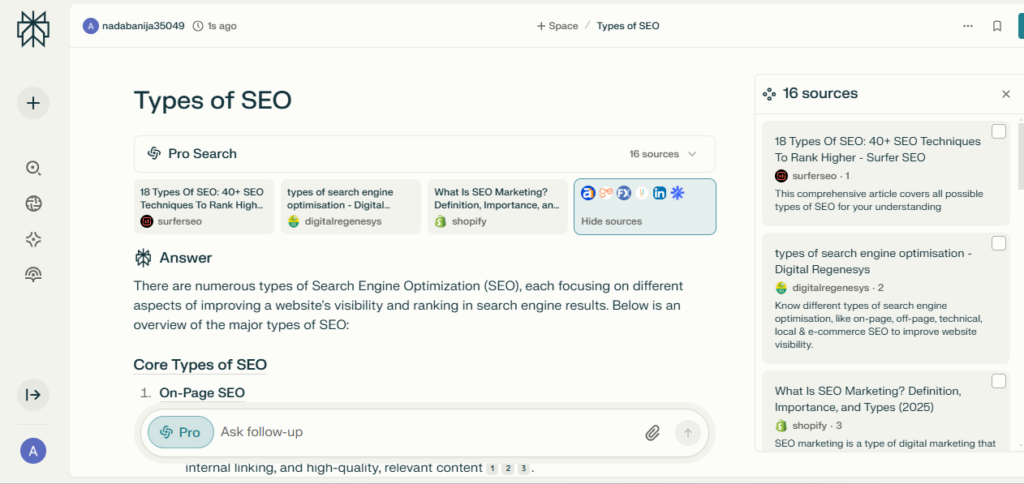
As you can see, Perplexity responds with concise answers, relevant sources, and clickable citations, all within the same screen.
The results are fairly similar to AI Overviews and ChatGPT’s.
Perplexity AI also supports follow-up questions, allowing users to refine and expand searches.
This study by The Information asked readers which generative AI product they’ve used to search for information online.
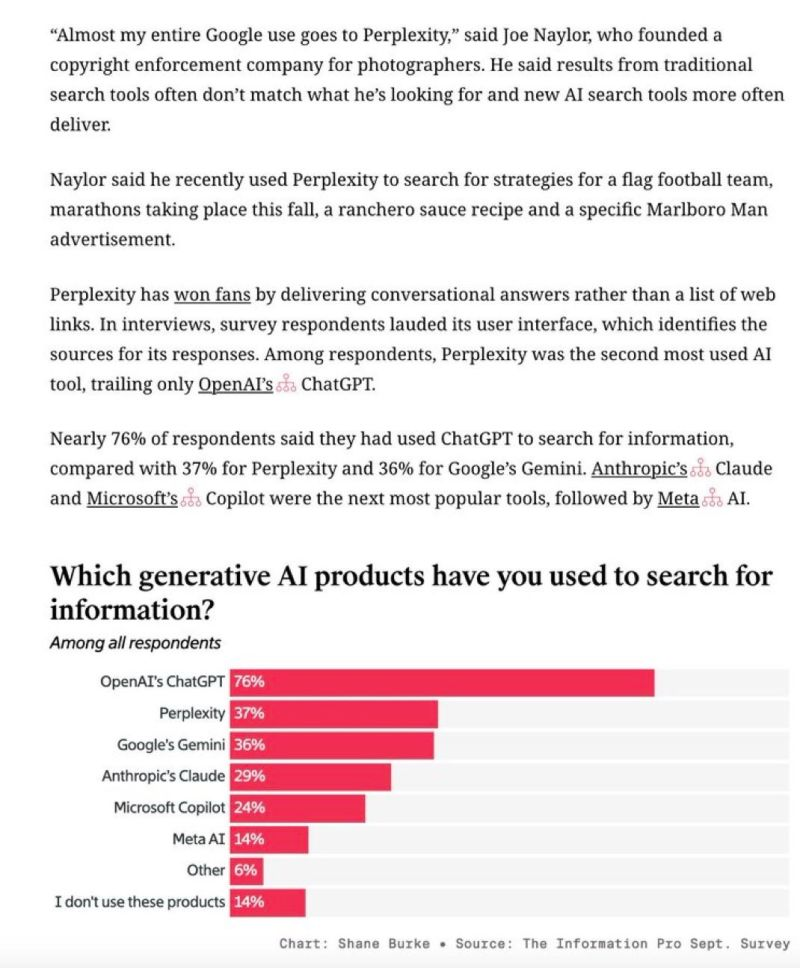
76% of respondents said they’ve used ChatGPT to search for information. 37% have used Perplexity while 36% chose Google’s Gemini.
9. AI Search Engines Offers Publishers Alternative to Traffic Source
ChatGPT Search and Perplexity AI are now referral traffic sources for publishers.
SEO and Content marketing expert, Rebekah May shared in her AI search optimization report that AI search engines now account for around 10% of her site’s traffic.
But May isn’t the only publisher getting a substantial amount of traffic from these tools.
According to Similarweb data, Forbes Perplexity referral traffic jumped from 10,800 visits in August 2023 to 236,300 in August 2024.
The New York Times saw a similar rise, increasing from 11,600 to 96,600 visits year-over-year.
A new study (released in February) by Semrush analyzed over 80 million clickstream records to investigate ChatGPT Search traffic.
Here are some of the findings:
- ChatGPT is sending traffic to more and more websites
Between July and December 2024, the number of unique domains receiving traffic from ChatGPT jumped 300%.
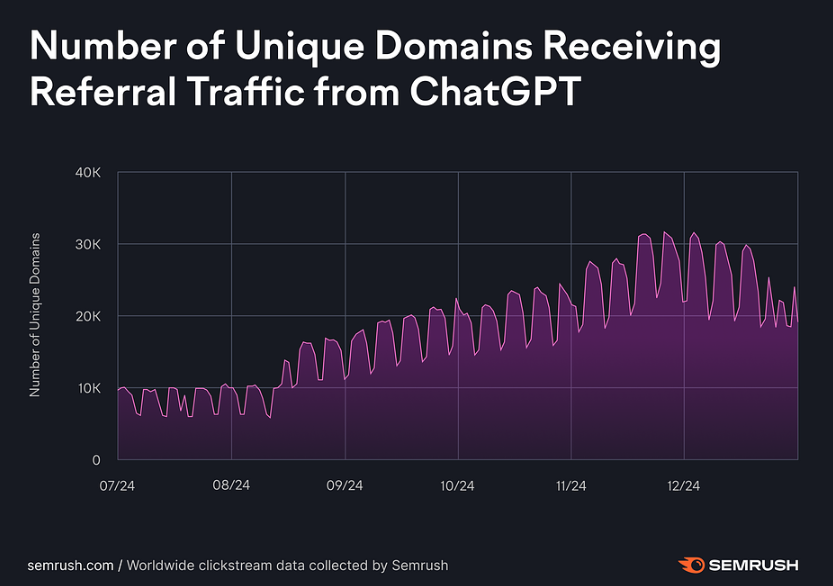
In July, ChatGPT sent traffic to fewer than 10,000 unique domains daily. By November, that number exceeded 30,000 daily.
- Online services receive the largest share of traffic
In the same study, Semrush analyzed the 10,000 most visited domains after ChatGPT interaction to further understand how ChatGPT traffic is distributed.
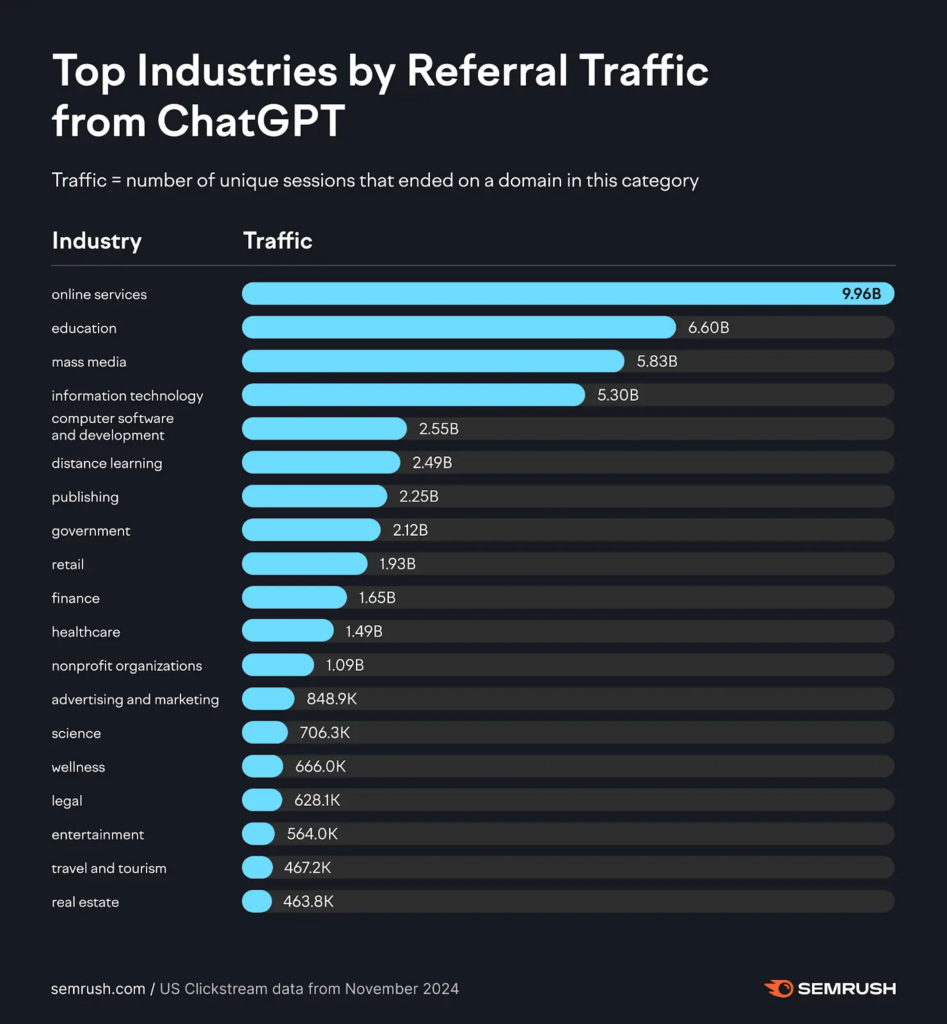
They found that websites in the online services industry dominate with approximately 10 million sessions.
With this AI search trend, our new SEO headache will likely be “how to land citations in AI search engine results”.
Chris Long, VP of Marketing at Go Fish Digital and Creator of The Splash Newsletter, shares his perspective on optimizing for Large Language Model (LLM) driven search:
“As the search landscape continues to be decentralized – optimizing for LLM-driven is going to be a must-have skill for any SEO in the future. LLMs are able to cater to a user’s extremely personalized needs, thus making brand mentions and traffic from these platforms invaluable.
For OpenAI, SEOs will need to understand the types of queries that trigger ChatGPT Search. What we’ve found is that listicle articles tend to perform quite well for brand mentions. Creating your own article can give your brand power to influence the response.
10. Google Still Dominates, But…
It’s premature to assume AI will replace traditional search engines.
However, there are serious indications that these tools would disrupt the market.
Weeks over weeks, ChatGPT’s search functionality has steadily gained traction.
BrightEdge monthly search data revealed that OpenAI’s search engine saw an impressive 44% month-over-month growth in referral traffic, while Perplexity surged by 71%.
This rapid growth underscores a rising demand for AI-powered search experiences.
BrightEdge even projected that ChatGPT could capture approximately 1% of the search market share in 2025, estimated to be over $1.2 billion in revenue.
Google’s move toward AI Overviews, which has steadily improved over the years, is part of the company’s strategy to compete with LLM-powered alternatives.
However, AI-first platforms like ChatGPT and Perplexity AI currently have the edge, thanks to their interactive experience.
They allow users to ask follow-up questions, refine their queries, and receive quick, ad-free results.
This streamlined experience is increasingly attracting users seeking faster, more intuitive answers.
11. High SERP Ranking Means Better AI Search Visibility
It’s not all bad news with AI search engines.
As search engines, we expect these tools to share fundamental functionalities with Google.
Their most important feature will be to find and serve users helpful information, which I think they are already doing.
The 80% overlap in the ChatGPT search and SERP result above signifies it.
Marcus Tober, Senior Vice President of Enterprise Solutions for Semrush, studied the correlation between LLMO and SEO results.
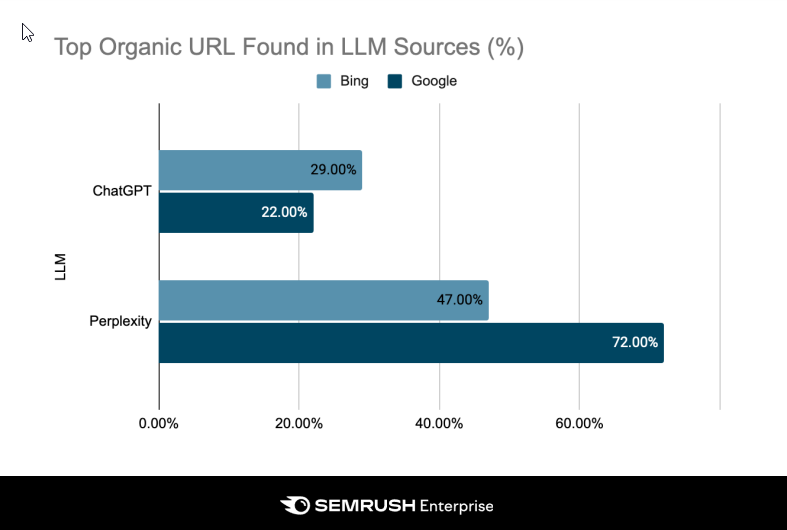
He found that:
- Perplexity’s results overlap 46% with Google’s top 10 organic rankings, but only 32% with Bing.
- ChatGPT-4 overlaps 69% with Bing’s top 10 and 48% with Google.
- 72% of Perplexity results include Google’s top-ranked page, showing a strong link between high Google rankings and visibility on Perplexity.
Overall, ranking well on Google increases your chances of appearing in ChatGPT Search results and Perplexity AI citations.
Search industry expert Kevin Indig puts hinted at these discoveries in a statement:
“The question is if you want to invest now for a potential first-mover advantage. I think it will pay off like it did with SEO, but if you’re looking for quick results, just focus on doing good SEO.
Tech SEO for LLM Crawlers, listicles, and driving more mentions across the web help with Generative AI visibility because LLMs still use search results from Google or Bing to ground their answers. But for how much longer? I think LLMs will soon develop their own weighting algorithms.”
12. User Generated Content Are Ranking High
It’s annoying, frustrating, and equally unpleasing to see a Reddit thread from 5 years ago outrank your recently published A+ content.
Unfortunately, that’s our new reality as publishers.
If you’ve searched for anything from “best budget gaming laptop” to “how to fix a leaky showerhead” lately, you’ve likely noticed this change.
These days, Reddit threads and Quora answers rank higher than traditional blogs or corporate websites.
But this isn’t new. It’s been happening since 2023. The trend continued through 2024 and we are witnessing the same in 2025.
Quora organic traffic has jumped from 95 million to nearly 460 million. That’s a whopping 400% increase.
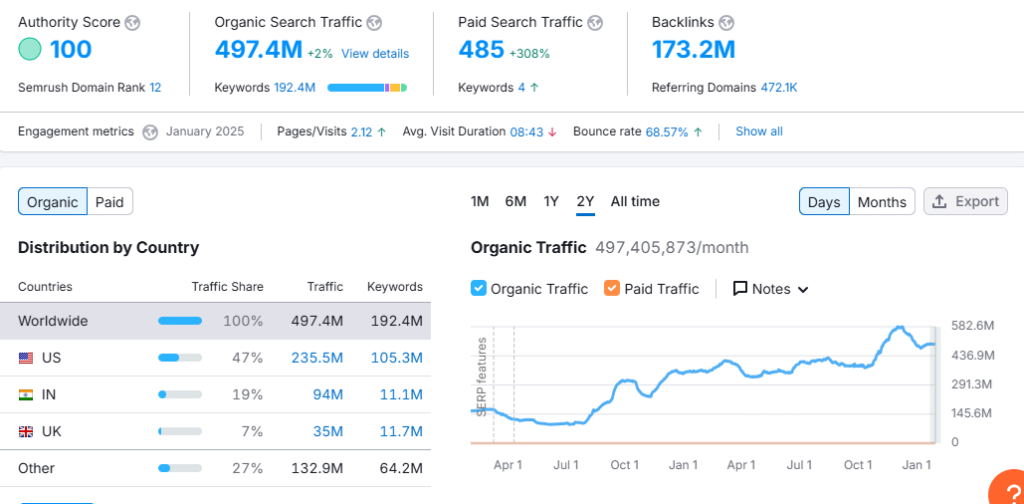
The story is the same with Reddit which now receives over 1.2 billion organic search traffic, over 600% increase from the 175.9 million of 2023.
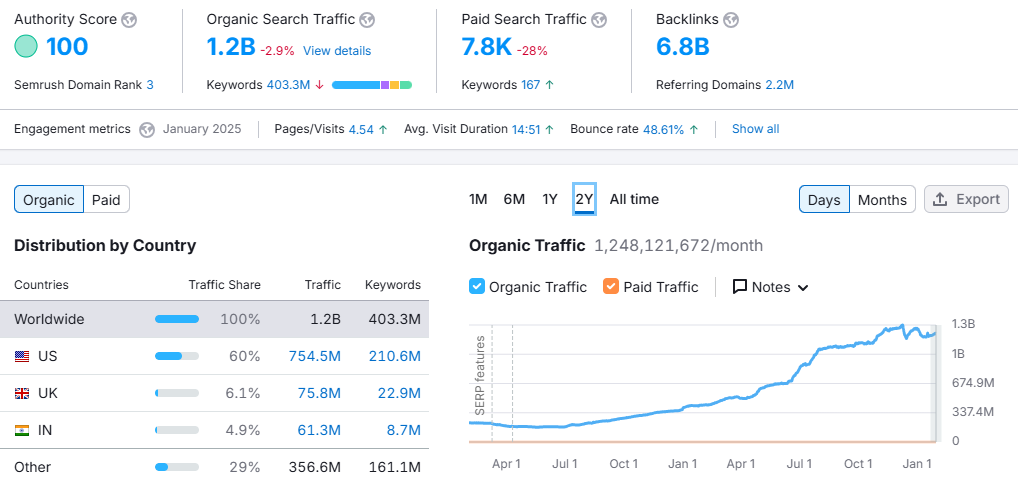
While Quora and Reddit figures are outliers, they aren’t the only forums doing well on SERPs.
Google now has a forum and discussion section on the SERP.
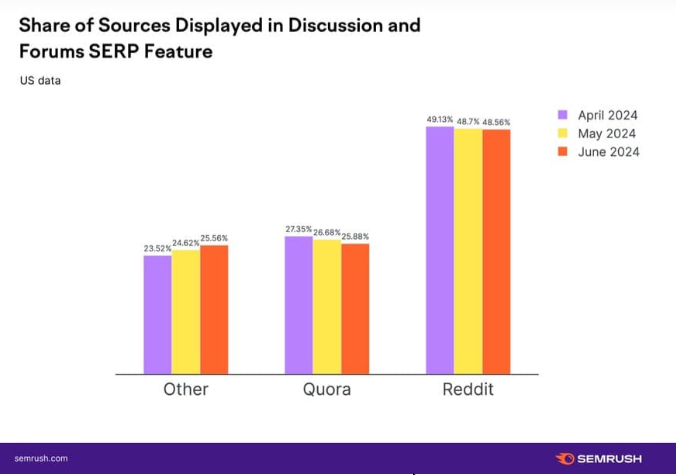
The key factor behind forums and community rising visibility on SERPs is Google’s shift toward prioritizing authenticity and user intent.
By Google’s logic, the algorithm must prioritize E-E-A-T signals.
It must favor content that demonstrates real-life experience over commercially motivated content.
A lot of marketers are dissatisfied with this shift. Not because UGC contents are favored in SERPs.
But because there’s more spam in Google-ranked forum posts than useful content.
And Google is doing nothing about it.
In fact, 51% of Reddit threads ranked for product-related search queries are havens of spam links. A practice expert now termed Parasite SEO.
Again, Almighty Google is unbothered.
That said, this trend highlights the growing importance of UGC and the need for SEO and marketers to incorporate it into their broader SEO strategy.
Here are a few tips on how to leverage UGC for SEO gains:
- Engage on platforms like Reddit, Quora, and niche forums where your audience actively seeks advice.
- Create content that’s helpful, transparent, and experience-based.
- Repurpose your content and share it on these forums.
- Incorporate user-generated content (UGC) and real customer stories into your website and blog.
- Optimize for conversational queries
- Focus on long-tail keywords and FAQ-style content.
13. SEOs are Inverting the Content Funnel
For decades, the traditional sales funnel has worked this way:
- Attract a broad audience at the top of the funnel (TOFU)
- Nurture interest in the middle of the funnel (MOFU) and
- Convert a fraction at the bottom of the funnel (BOFU).
SEOs are flipping this script.
They now prioritize bottom-funnel content to drive immediate conversions, and then use those wins to fuel top-of-funnel growth, which makes perfect sense in this era of general traffic decline.
Instead of chasing high-volume keywords for sheer traffic alone, they focus first on searches tied to genuine buying intent, even if they drive less initial traffic.
This shift is partly triggered by the saturation of top-funnel content and the need for businesses to shorten sales cycles.
The internet is flooded with generic “what is” and “how to” content.
A larger percentage of top-funnel keywords (e.g., “what is CRM software”) now have a difficulty score above 70 (on a 100-point scale), making them nearly impossible for new players to rank for.
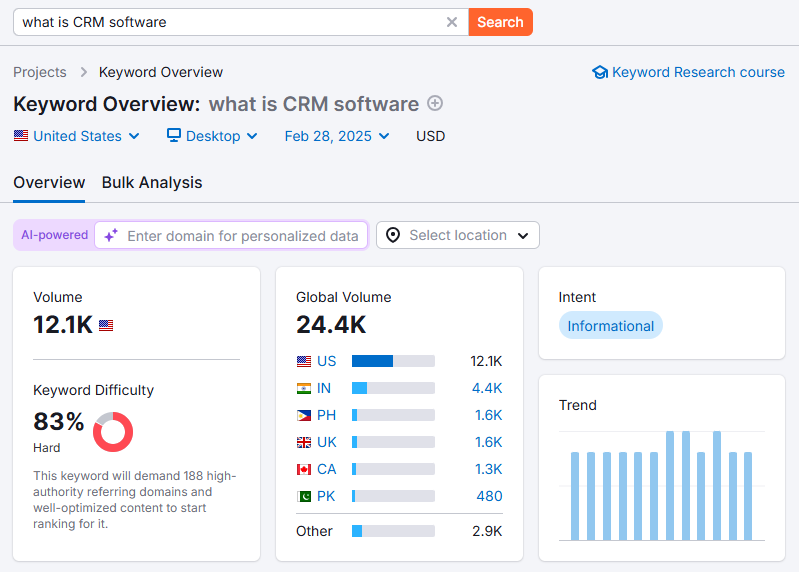
Meanwhile, bottom-funnel keywords like “best CRM software for small businesses” have a far lower difficulty score but a higher conversion rate.
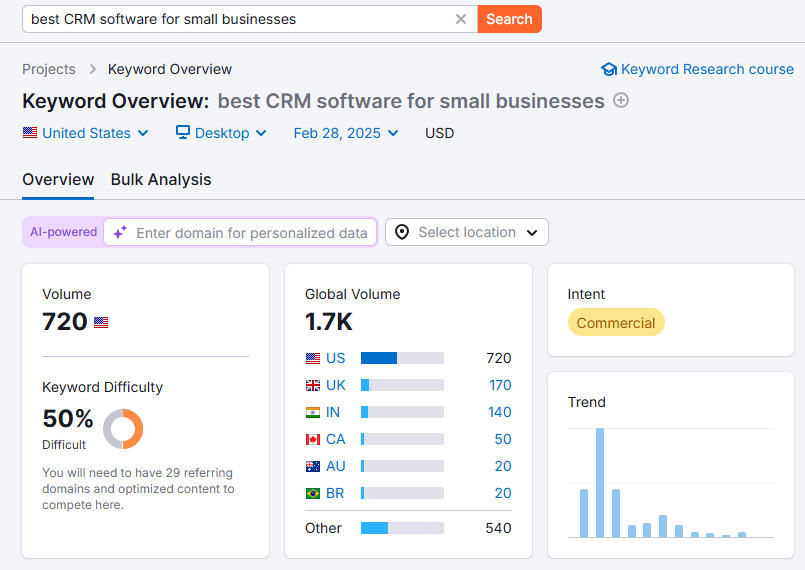
Some Examples of Bottom-of-the-Funnel Keywords include:
- [Product Category] + for [industry/role/business type]: E.g., “best time tracking software for freelancers”, “HR software for startups”
- [Competitor] + alternatives/competitors: E.g., “Slack alternatives”, “HubSpot competitors”
- [Your brand] vs [Competitor]: e.g., “Airtable vs Notion”, “Zoom vs Microsoft Teams”
In this Geekbot case study, Grow and Converts SEO Content Strategist, Daniel Levi, detailed how 22 BOFU contents generated a 25x higher conversion rate than 43 TOFU posts, despite receiving significantly less traffic.
Here’s the data:
| Content | Traffic | Conversions | Conversion rate | % of Total Conversion |
| 22 BOFU Content | 28,190 | 1,348 | 4.78% | 77.24% |
| 43 TOFU Content | 204,303 | 397 | 0.19% | 22.76% |
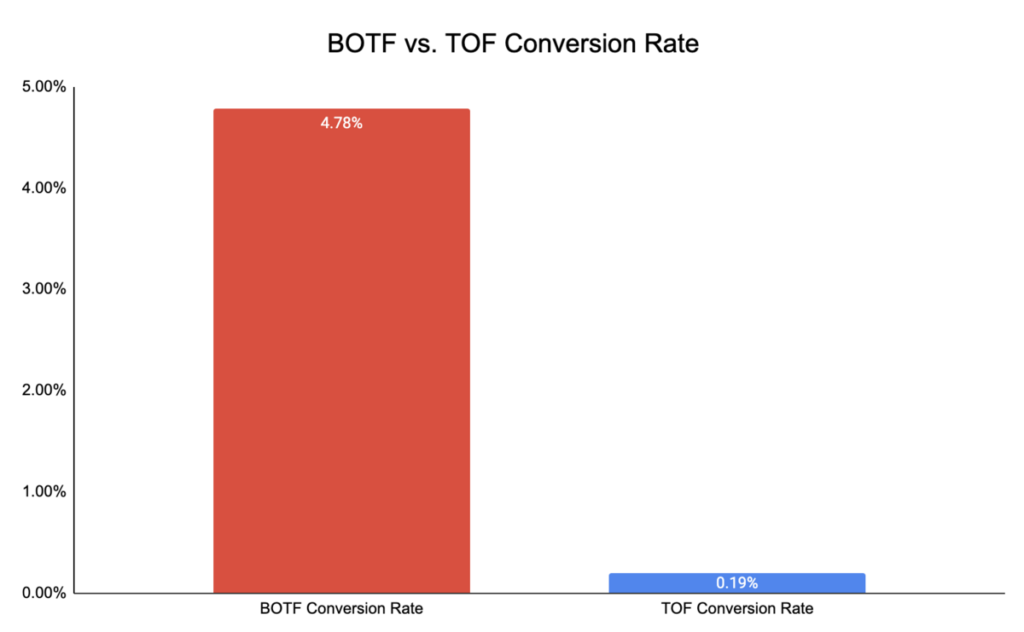
Benji Hyam, the company Cofounder wrote:
“While many companies are focused on ranking for high-volume keywords in their content marketing and SEO efforts because of the traffic potential, we prioritize lower-volume, high-buying-intent keywords because the conversion potential is much greater than going after high-volume keywords.”
Mapping content directly to the user’s pain point helps brands create highly targeted pages that attract qualified visitors. These people are more likely to convert into leads, signups, or sales.
Today, more and more SEOs are gravitating in this direction. If not for anything, it’s a judicious use of the little traffic Google sends their way.
That’s why the company evangelizes pain points as an SEO strategy.
In the same vein, experts like Tasmin Lofthouse now preach Emotional SEO.
This trend is forcing many SEO and marketers to change their approach.
With this SEO trend, content pieces shouldn’t just rank and inform. They must now connect and sell.
Stay on Top of SEO Trends in 2025 and Beyond
In the end, search is evolving, and the way we approach SEO must evolve with it.
Staying on top of SEO trends means keeping one eye on what’s changing and the other on what’s always worked.
Of course, AI-powered search engines are ushering in a new era, but one thing remains constant: creating high-quality, contextually relevant content that satisfies user intent will forever be a winning SEO formula.
And let’s be clear, Google isn’t going anywhere. It’s too early to start thinking about throwing away Google SEO playbook.
All you need to do is update and adapt it for the realities of 2025.


